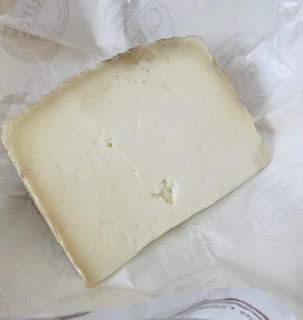 |
| Thomasville Tomme cheese |
I have to preface this blog post by saying any complaint I'm going to share has nothing to do with Thomasville Tomme cheese itself or the company that makes this lovely product. My criticisms are directed at the store where I purchased the cheese, and it's not the first time I have been disappointed by this large chain store. It may not be worth mentioning, though, other than to say that when a cheesemonger tries to sell you old moldy cheese and claims that's how the cheese is supposed to look, take a look at the cheese maker's website before you put down any cash and end up with something well past its prime. More often than not, you will find a description of how the cheese is supposed to look, smell, and taste, and while mold occurring on cheese usually isn't anything too terrible, in this case, Thomasville Tomme isn't supposed to have it. In fact, Sweet Grass Dairy suggests cutting away any mold that happens to develop after the cheese is exposed to oxygen, so if anyone tells you that the mold on this particular type of cheese is not just acceptable but desirable and intended, don't trust her.
 |
| Cut away any mold that develops. |
On a brighter note, and bright is a great description of this cheese, Tomasville Tomme is a beautiful everyday cheese with a lot of versatility. While it smells like a standard Swiss cheese and has a strong nutty flavor, there's also a wonderful earthy and mushroomy aftertaste, reminiscent of the flavor one finds in a bloomy rind. It's very good. My reaction to eating this cheese is like the second "woo" in this video, displaying genuine appreciation without swooning, jumping up and down, or falling over backward. Every time I eat it, I think, "Wow, that's a really nice cheese."
 |
| Thomasville Tomme is a nice everyday cheese |
As far as flavor goes, there are notes of straw and grass without any funkiness or dankness. Because the milk used to make this cheese comes from cows that feed primarily on grass, the flavor is fresh, full, and rich with a hint of butter and sweetness. The various subtle notes make a lovely combination.
In a previous post, I discussed tomme-style cheese. In brief, these cheeses are traditionally lower in milk fat, are less acidic, and have a rustic natural rind. Thomasville Tomme is no exception, though I prefer this to many tomme-style cheeses I have tried. There's just something more intriguing about this cheese. It's not bitter or chalky, and it's not dry. In fact, it has an unctuous, beefy interior without being truly oily.
 |
| The interior of Thomasville Tomme is beefy. |
Like traditional tomme-style cheese, Thomasville Tomme is made from raw milk sourced from the same farm, and animal rennet is used. It's aged approximately 60 days. Unlike many larger companies, Sweet Grass Dairy focuses on sustainability. According to the Sweet Grass Dairy website, Founders Al and Desiree Wehner moved from conventional dairying to a more natural method. They wanted to allow their cows to eat grass. These barn-free dairy cows in Georgia produce milk year-round.
It's not surprising that Thomasville Tomme has won several awards including first place at the American Cheese Society Competition in 2002, and, more recently, a bronze award in the World Cheese Competition in 2021.
Although this cheese can be used in cooking, it really shines as a table cheese. Its flavor is more pronounced at room temperature. Pair this cheese with rye bread and dried meat or sausage, seed crackers, green grapes, apricots, roasted nuts, candied pecans, or sun-dried tomatoes. Cube it and add it to a fresh spring salad with Champaign vinaigrette, or add it to a club sandwich.
 |
| Grenache pairs well with Thomasville Tomme. |
Serve Thomasville Tomme with a California Merlot, Pinot Noir, Madrain, Gamay, Grenache, Chardonnay, or a Sauvignon Blanc blend. You can also try it with a Chenin Blanc or even Chanpagne. Those at Sweet Grass Dairy suggest a hoppy Pale Ale if beer is more your thing, but you can also try it with a Doppelbock.




















